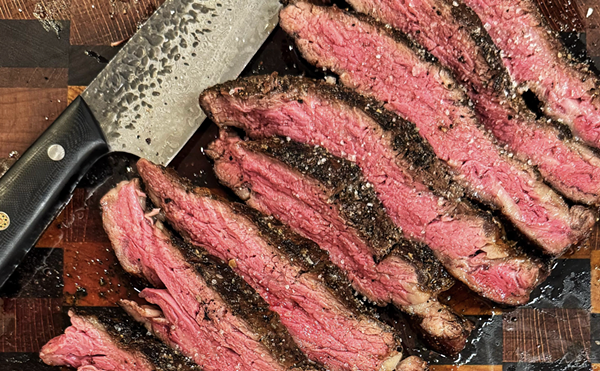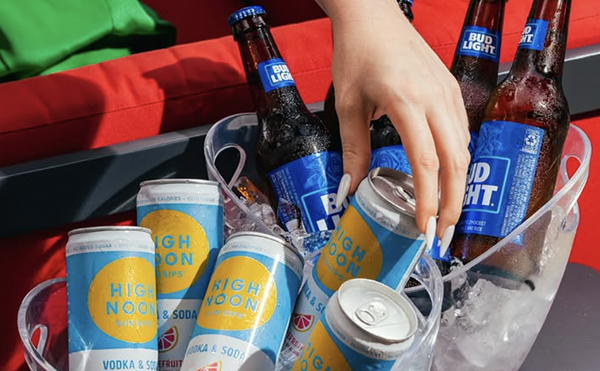You may recall that Andrew Zimmern, food maven, professional eater, and award-winning writer and television host was in Miami in early January to film several Miami restaurateurs and chefs for his web series, Appetite for Life: DIY Kitchen.
The Miami episodes are up and Zimmern can be seen all around town, eating gator at Mojo on the Go, roasting his own brew at Panther Coffee, planting an indoor herb garden at Semilla Eatery & Bar, canning jelly at PepperJelly Co., baking a pie with Fireman Derek, and crabbing with Luis Garcia from Garcia's Seafood Grille & Fish Market.
The site also has great recipes and (naturally), DIY tips, including how to make a crab trap, courtesy of Luis Garcia from Garcia's Seafood. The trap, made from basic supplies found around the house and at the local hardware store, The project should take a few hours and the result works (check with your local city rules to see where and when it's OK to catch crabs).
Here's how to do it, courtesy of Andrew Zimmern and Luis Garcia:
Garcia's Seafood Crab Trap
Here's everything you need to complete this project:
Hammer
Handsaw
Staple gun
1/2-inch to 3/4-inch staples
1 1/2-inch galvanized nails (approximately 150)
2-by-1-inch wood slats (approximately 45)
Plastic jug with at least a 9-inch diameter to allow crabs to pass through
Old tennis ball, bicycle tubes or tires to cut out hinges flaps
Pork bone bait
Heavy-duty wire
Rope
1. Cut and organize your wood into two piles. For the first batch, you'll need 25 to 30 2-by-1-inch pieces cut into 36-inch lengths. For the second batch, you'll need 15 2-by-1-inch pieces cut into 20-inch lengths. The final dimensions of the crab trap will be approximately 36 inches long by 15 inches high by 20 inches wide.
Remember: Restrictions for crab trap dimensions vary by location. Be sure to check with your local fish and wildlife office for specific policies.
2. Salvage a plastic water or milk jug from your recycle bin. Cut off both ends of the plastic container. Make sure the container is large enough for an adult crab to travel through (at least 9 inches in diameter). You'll use this plastic portal later when creating the entrance to the crab trap on the top panel. The plastic portal extends down into the crab trap and prevents crabs from escaping the trap once they maneuver inside.
3. Assemble the side panels. Build the trap one side at a time. Remember to leave a 1/2-inch gap between each wood slat. Use a hammer and 1 1/2-inch galvanized nails to assemble the frame and wood slats for one of the 36-inch side panels. Assemble the frame and slats for the 20-inch end panel. Tack together another 36-inch side panel and nail it to the 20-inch end panel you just nailed together. Nail the final 20-inch end panel to the ends of the 36-inch side panels to form a rectangular box with no top or bottom.
4. Assemble the bottom panel. Follow the same process used to build the box frame to make the bottom panel. Place the box frame on a flat surface and nail on the bottom panel. Flip the box over so the bottom rests on the flat surface. You should have what looks like a wood crate without a lid.
5. Frame and assemble the entrance on the top panel. The top panel is the most complex part of the trap because it has two holes: one for the plastic jug entry portal and the second for the trap door. At the left end of the top panel, frame the hole for the plastic jug portal by nailing two support wood slats across the width of the crab trap. Make sure to measure the diameter of the plastic jug to figure out how far apart to space the support slats. Cut a few slits at both ends of the plastic jug to create nailing flaps. Bend the plastic flaps over the support pieces and attach them with a staple gun. Nail three 36-inch slats above and below the entry portal. You'll have two gaps on either side of the entry portal. Patch the gap on the left with wood slats cut to the correct size. You'll fill the other gap with the trap door.
6. Frame and assemble the trap door. To figure out the dimensions for the door, you'll need to measure the width and height of the gap left open for the trap door in the step above. Build the trap door by cutting 2-by-1-inch wood slats to match the size of the opening and nailing them to two wood support slats. Let the wood support slats extend out about 1 inch so the ends can slip under the wood slats on the top panel to lock in place. Cut two 2-inch lengths from an old tennis ball or bicycle inner tube to use as the hinges for the trap door. Slide the trap door into the "locked" position (extended 1-inch ends under the top panel slats) so the rubber hinges are full extended. Staple hinges on each end. The trap door should be flush with the top of the crab trap. Test the hinge operation to ensure proper fit by sliding the door toward your body. The trap door should slide down and clear the top panel slats so you can swing it open like a normal door. If you're confused, watch Garcia and Andrew walk through the steps to build the trap door.
6. Attach the bait. Pig bones work well, but read up on the bait that works best for crabs in your area. Wrap strong wire around one end of the pig bone. Dip the pig bone down the plastic entrance hole of the trap. Hammer a nail into the framing near the mouth of the hole and wrap the loose end of the wire securely around the nail, letting the pig bone bait dangle near the center of the trap.
7. Toss trap in the water and wait. Tie one end of a rope to the crab trap and the other end to a secure point on the shore, dock, boat or deck. The rope should be slack and long enough to allow the crab trap to rest at the bottom. Drop your crab trap into the water and leave overnight. Come back in the morning to see how big of a crab feast you'll be cooking for all of your friends.
*Remember to check local laws for trapping restrictions. There may be limits to the number, size and gender of crabs that can be caught.
Follow Laine Doss on Twitter @LaineDoss and Facebook.
Follow Short Order on Facebook, Twitter @Short_Order, and Instagram @ShortOrder.












